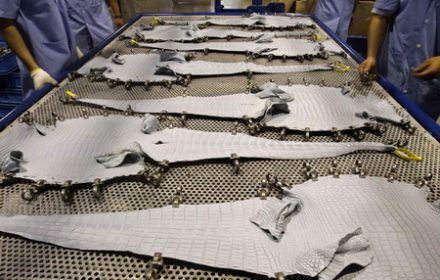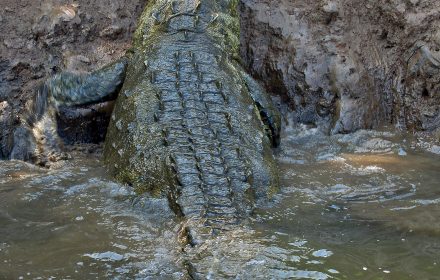Crocodile is one of the ancient of animals that have survived more than millions of years. It played an essential part in the earliest spiritual lives of native peoples in many countries. In Christian antiquity and according to the Bible, it is a monster of chaos and the devil. Hence, early Christians during the Middle Ages chained stuffed crocodiles on church walls representing chained devil. Thousands of years ago, armors for warriors were designed using crocodile skins. When soldiers wore these armors, they took on the spirit of toughness and trusted their primal instincts making them go deeper for answers.
Crocodile
Nile crocodiles are prehistoric survivors of dinosaur antecedents. In their present form, they date back 80 million years. The Egyptians kept them as pets 26 centuries ago. Nubian fishers, to this day, stuff them and mount them over their doorsills to ward off evil. The main features of crocodile are its four splayed, short legs, a scaly hide, powerful tail and a strong jaw. Although they are scary creatures, their group dynamism and individual behavior are often fascinating and amusing to both the biologists and the general public alike. Pollution, habitat loss, and illegal hunting have severely depleted their numbers.
Some countries produce crocodile skin and process the hides to leather. In other words, they have crocodile farms and are also equipped with the infrastructure to transform the skin to leather. But some other countries that supply raw crocodile skins such as Kenya are in a dilemma. They ask whether it would not be profitable to tan them locally in their country rather than export them in the wet salted state. When it comes to owning the leather processing business the immediate practical solutions available at their disposal are to either, do partial leather processing or run a pickling plant.
Leather may be the simplest manufactured material in prehistoric times. But manufacturing leather in modern days using natural and synthetic tans and a variety of treatments is complicated. The exact procedures, chemicals, and equipment used are subject to variation and change between tanneries. Crocodile leather passes through many convoluted stages, and routine treatments like rinsing, washing, draining, or partial drying often separates the processes. Surely amateurs can make reasonably good leather because the core operations are standard. However, making the best crocodile leather is a long and skilled procedure as the tanning and finishing of the skins is very specialized.
Crocodile leather is considered one of the most expensive leathers in the world. It has a prominent place in the lines of most global upmarket brands such as Vuitton, Versace and Gucci. Although crocodile leather fashion is seasonal, the actual goods rarely lose its value due to scarcity, source, and demand, not to mention the level of craftsmanship. Crocodile leather is unique due to its elegant patterns and colors that give it a subtle allure. Depending on the positions and sizes of the leathers, appropriate products will be crafted using almost all of the leather so as to shrink wastage.
People farm crocodiles mainly for their skin to make high-quality leather. Crocodile skin undergoes processing and tanning before it converts to leather. It is exotic due to its rarity and the timeless craftsmanship required to produce a finished hide. The tail, legs, head, and many other body parts contribute unique styles, creating a diverse palette, making lipstick holders and money clips with them. As a material for making accessories, crocodile skin is a constant source of wonder. The supply of total skins available globally is small. Its rarity determines that products made of crocodile skin will never be mass market.
Nile crocodiles are very stiff and not very comfortable on land, and they stick out like sore thumbs. Mostly, they move only when needed or when feeling threatened. But in the water, they are way too easygoing, often hiding and running about continually. They are extremely alert and have the capacity to swim at high speed and incredible agility in the water. Interestingly enough, Nile crocodiles swim almost effortlessly and it comes as second nature. Hence, people often wonder how crocodiles that do not have fins or gills like other aquatic animals, spend almost their entire lives in the water.
In Kenya, the most common type of crocodile is the Nile crocodile. A Nile crocodile is not a beautiful sight. It is unsightly. But it is fascinating to watch, albeit from a distance. It has a purple under part and a bronze colored back. The flanks are yellow in color and scutes form on the tail and back. The colors keep changing, as it grows old. The Nile crocodile is widely distributed in the Southern Africa including Botswana, Namibia, Zimbabwe, and Zambia and has a healthy population in many East African countries such as Ethiopia, Somalia, Kenya, Uganda, and Tanzania.
Crocodiles have played an important part in human culture. Some people in certain parts of the world worship them as supernatural creatures while some others use them for decorative or medical purposes. But hunting for skin and meat caused the greatest havoc to its survival. And the value of crocodile skin depends on several factors. Needless to say, the Nile crocodiles found in Kenya is one of the highly sought out skins for making high-quality leather. It is the ossification under the belly that is a major factor that separates the skin of Nile crocodile from the other crocodile species.
One of the largest crocodilians is the Nile crocodile found in eastern Kenya. It is a marine predator that has evolved over centuries. It has a streamlined body, a powerful tail, and webbed hind feet. But the most distinguishable feature of a Nile crocodile is the enlarged tooth on the lower jaw, which juts out and is visible when it keeps its mouth closed. As the size of its body increases, its taste bud and appetite changes as well. And what transforms with that is its food hunting behavior. However, what remains unchanged is the human-crocodile conflict in the wild.










